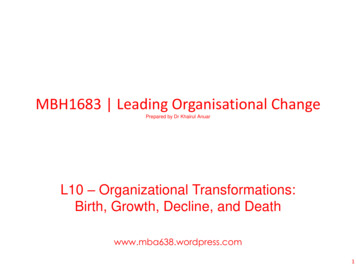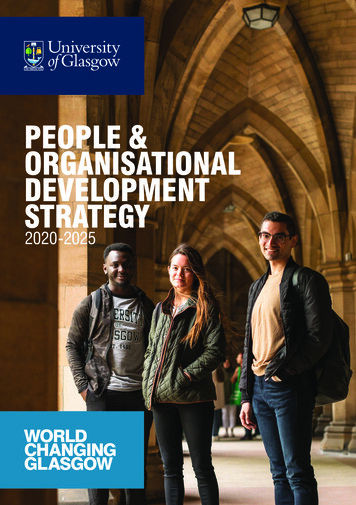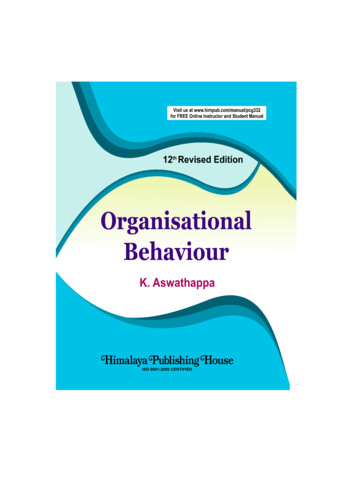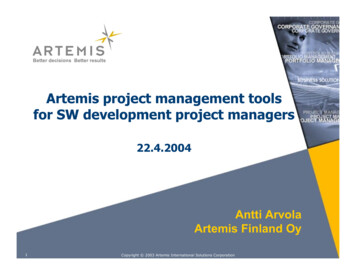
Transcription
Project Managementand the OrganisationalStrategyAn ESI InternationalWhite Paperwww.esi-emea.comTel: 44 (0) 20 7017 71005.
Table of ContentsProject Management and the Organisational Strategy2An Overview of the Strategic Management Process3The Need for a Project Selection and Priority System5Questions to be answered5The Selection Process7Proposals Screening7The Priority Team8Selection Criteria8Assessing Results10Summary11Project Management and theOrganisational StrategyProject management is rapidly becoming a standard way of doing businessin organisations. We accomplish a considerable portion of our typical firm’seffort through projects. Projects are becoming the tools of implementingthe business strategy of an organisation. Every project in an organisationshould contribute to its strategic plan. How can we ensure this linkage? Weneed to make sure that we integrate projects within the strategic plan. Thisintegration requires a process for prioritising projects by their contributionto the plan. In this white paper, we will introduce the strategic planningprocess, how it relates to project management, and how to implement aproject selection and prioritisation process.5. ESI International, Inc. 2006 All rights reserved.2Project Management & Business Strategy
An Overview of the Strategic Management ProcessIn customer driven organisations, vision, mission, and goals are set to meet theneeds of the customers. The vision states, “What we want to become.” We need tocommunicate this vision throughout the organisation. In addition, we need to makesure that everyone in the organisation is aware of the organisation’s mission, “Whatour business is and how we go to achieve our vision.” Business goals translate thevision, and the mission into broad long-term, measurable, and tangible terms. Theobjectives answer in detail where a corporation is heading or when it is going to getthere. These objectives should set targets for all levels of the organisation. Eachlevel of the organisational objectives should support the higher-level objectives inmore detail. Table 1 depicts examples of goals, strategies and objectives.CompanyBusiness GoalBusiness StrategyFord Motor Company Regain market sharerecently lost toGeneral Motors Regain qualityreputation that wasdamaged because ofPinto gas tankexplosions Resize and downsizepresent models Emphasise use ofprogrammedcombustion enginesinstead of diesel enginesBurger King Increase productivity Increase peopleefficiency Increase machineefficiencyCP Railroad Continue companygrowth Continue companyprofits Modernise Develop valuable realestate holdings Complete an appropriaterailroad mergerTable 1: Examples of Business Goals and Related StrategiesThe development of strategies to meet these needs and goals answers thequestion of “What we need to do to achieve these goals.” It requires anextensive analysis of the internal and external environments. Based on apolitical, economic, social, and technological analysis (PEST), we analysethe external environment to identify opportunities, and threats. We analysethe internal environment looking for strengths and weaknesses such asmanagement, facilities, core competencies, product quality, technology,and financial resources. The deliverable of this analysis is a set of strategiesdesigned to best meet the needs of the customers.5. ESI International, Inc. 2006 All rights reserved.Project Management & Business Strategy3
Implementation of these strategies requires actions, and completing tasks.It answers the question of “How are we going to realise these strategies.”Implementation must include attention to the following key points: Executing the work requires allocation of resources such as funds, people,and equipment. Organisational resources are limited. In addition, multiplegoals frequently impose conflicting demands on resources. This requires amechanism for allocating resources based on organisational priorities. Implementation requires an organisational structure that supports projects. Project management processes for planning, executing, and controlling areessential to ensure that we are able to implement strategies effectively andefficiently. We need a project selection and priority system to ensure strong linkagesbetween projects and the strategic plan.Step 1:Step 2:Step 3:Define & review vision&missionAnalyse external &internal environmentsIdentify goals &objectivesStep 4:Step 5:Formulate strategies toachieve objectivesImplement strategiesthrough projectsFigure 1: Strategic Management & Project ManagementFigure 1 shows the strategic management process and its relationship toprojects.5. ESI International, Inc. 2006 All rights reserved.4Project Management & Business Strategy
The Need for a Project Selection and Priority SystemThe need for a project selection and priority system stems from thefollowing observations: Organisations frequently pursue many projects simultaneously. Almostinevitably, the number of small and large projects in a portfolio exceedsthe available resources such as funds, equipment, and competencies. Projects are taking place in organisations. Politics exist in everyorganisation and can have a significant impact on project selection.Many projects within companies are associated with the term “sacredcow.” We often use this term to describe a project sponsored by a highranking official. Without an effective project selection and priority system, the capacityoverload coupled with project politics will lead to frustration, confusion,and inefficient use of resources.Questions to be answeredSome of the questions that we need to tackle when we are considering aproject selection and priority system are as follows: How can we minimise the power of politics? How can we consistently prioritise projects to support the organisationalstrategy? How can we use the prioritised list of projects to allocate organisationalscarce resources? How can the process encourage bottom-up initiation of projects thatsupport organisational goals and strategies?5. ESI International, Inc. 2006 All rights reserved.Project Management & Business Strategy5
A fact is that we are always going to have more potential projects or proposalsthan the capacity of the organisational resources. Thus, we need a systematicprocess that will select projects and allocate resources to these projects inorder to maximise value added. Selection of projects from a slate of projectsrequires the use of a decision model in association with specific criteria.The benefits of carefully selected criteria are as follows: More effective planning of organisational resources More efficient utilisation of organisational resources A portfolio of projects that balance opportunities, and threats given availableresources Keeping the organisation stakeholders focused on the most critical projects Obtaining consensus as to which projects have the highest priorityNevertheless, when we have implemented a project selection and prioritysystem in our organisation we met enormous skepticism and resistance.Typical responses include the followings: We all know which projects are the most important ones All projects are important Our business is changing on daily basis. We do not need an extra layer ofbureaucracy, which limits our flexibility.Responses such as the above suggest a serious need for a project selectionand priority system. Nevertheless, the development and the implementationof such a system will not materialise without the support and sponsorship ofupper management.Practitioners can choose from a relatively large number of project priority andselection models. Picking a selection model is highly dependent on certainorganisational attributes such as industry, risk aversion level, technology,competition, management style, and markets.Selection models should encompass multiple criteria such as profitability,researching new technology, public image, core competencies, and strategic fit.5. ESI International, Inc. 2006 All rights reserved.6Project Management & Business Strategy
The Selection ProcessRarely is the situation where we “must” select a project; otherwise, theorganisation will fail or will suffer from a severe loss. If a project falls in the“must” category, we ignore all other selection criteria. The question is whenwe place a project in the “must” category. The answer is when the majority ofthe organisation stakeholders agree that the project is crucial and we need toimplement it. There is no other choice but to implement the project in order toensure the continuity of the organisation. For all remaining projects, we will usemultiple selection criteria, which link the project to the organisational strategy.Proposals ScreeningProposals for projects come from internal and external sources. In mostsituations, organisations have more proposals on hand, than they canpursue. These proposals have to go through a screening process. Figure 2shows a screening process used by one of my clients. The prerequisites forimplementing an effective screening process are: Publishing of the selection criteria so that self-evaluations are carried outby sponsors before they are submitted to the priority team Publishing guidelines and templates for developing a business casewhich will facilitate the evaluation process by the priority teamIdeaSupportingdata &analysisTerminateRejectSelfevaluationPriority teamassessmentPursueInputNeed more informationIRR, ROI,payback,need,strategic d forresourcesFigure 2: Proposal Screening Process5. ESI International, Inc. 2006 All rights reserved.Project Management & Business Strategy7
The Priority TeamIn order to implement an effective project priority and selection process, weneed to clarify the roles and responsibilities of the priority team. The projectpriority team is responsible for: Evaluating project proposals on the basis of the selection criteria Accepting or rejecting proposals Publishing the score of each proposal and ensuring the process is open and free Balancing the portfolio of projects for the organisation Evaluating the progress of the projects in the portfolio over time Reassessing organisational goals and priorities if conditions changeSelection CriteriaWe need to base the project selection criteria on the organisational criticalsuccess factors and strategic goals. Failure to select the right factors willrender the priority and selection process useless. Example of typical selectioncriteria used by one of my customers: Alignment with core competencies Alignment with strategic goals Internal rate of return in excess of (a certain number say 15%) Improve customer service Urgency5. ESI International, Inc. 2006 All rights reserved.8Project Management & Business Strategy
Management weights each criterion by its relative contribution andimportance to the organisation’s goals, and strategic plan. The projectpriority team evaluates each project proposal by its relative contributionor benefit to the selection criteria. The priority team assigns a spectrumof values for each criterion ranging from low (0), to high (10). This valuerepresents the proposal’s fit to the specific criterion. Table 2 shows aproject selection matrix. For example, “Proposal 1” appears to fit wellwith the strategic goals of the organisation since the priority team gaveit a score of seven. However, “Proposal 1” does little to support corecompetencies since the priority team gave it a score of two. The laststep in this model is to apply management weights to each criterion byimportance using a spectrum of values ranging from low (1), to high(3). For example, improve customer service has a weight of three whileurgency has a weight 2. Note that urgency is different than “must”category discussed above. Although proposal 4 appears to have someurgency, yet we did not classify it as a “must” project. That is why weare analysing it with other proposals. In rare cases such as two projectshave the same score; the priority team may pick the project that has lessdemand on organisational resources.SelectionCriteriaAlignmentwith corecompetenciesAlignmentInternal rate Improvewith strategic of return in customergoalsexcess ofservice15%Urgency TotalScoreWeight2.03.01.53.02.0Proposal 12735350.5Proposal 23415340.5Proposal 39633355.5Proposal 45097856.5Proposal 53849469.5Table 2: Project Scoring Matrix5. ESI International, Inc. 2006 All rights reserved.Project Management & Business Strategy9
Assessing ResultsThe project priority system selects which projects we need to pursue basedon their support to the organisational strategy. In addition, we need a modelthat assesses the long-term effectiveness of the project priority system. Theassessment model focuses on the performance in five main areas: Customer Internal Innovation Knowledge transfer Financial measuresWe need to collect metrics in order to analyse and assess the effectiveness ofthe project priority system. The following list shows some typical metrics thatwe use to assess these five main areas: Customer- Sales compared to industry norms- Percentage of on-time /within budget/according to specifications projects Internal- Time to market a new product or service- Reduction in design time Innovation- Sales generated from new products Knowledge transfer- Savings generated from improvements in project management processes Financial measures- Return on investment- Internal rate of return- Cash flow analysisWe need to measure these metrics over a period and compare them withindustry norms if they are available in order to have a fair view of the companyperformance.5. ESI International, Inc. 2006 All rights reserved.10Project Management & Business Strategy
SummaryA project management approach to business problems and opportunitiesis becoming the norm rather than the exception. Projects are the tools forimplementing the strategy of the organis
Burger King Increase productivity Continue company growth Continue company profi ts CP Railroad Resize and downsize present models Emphasise use of File Size: 250KBPage Count: 12











